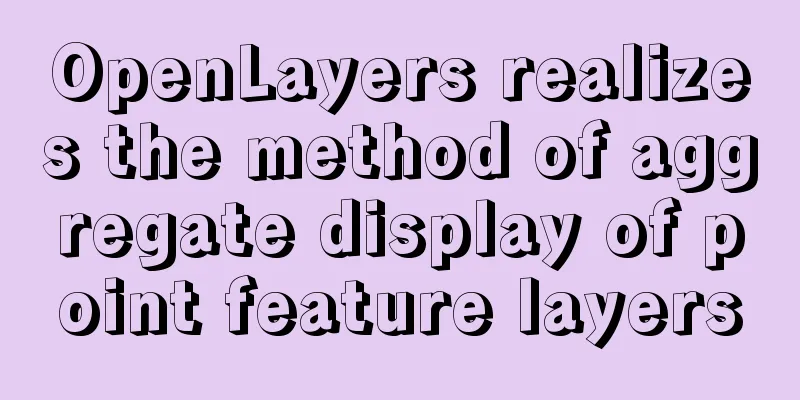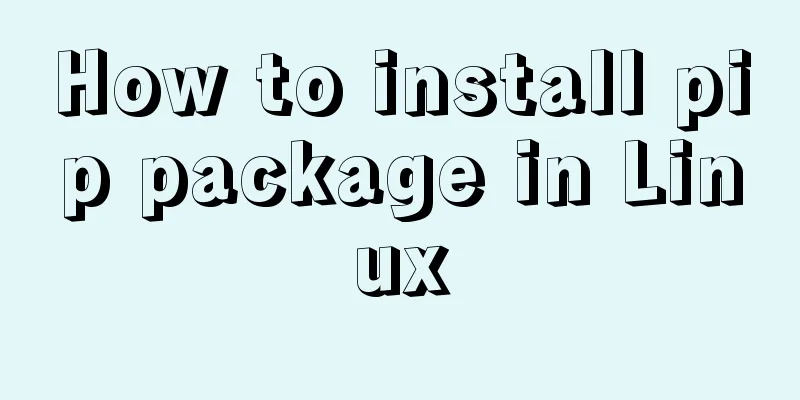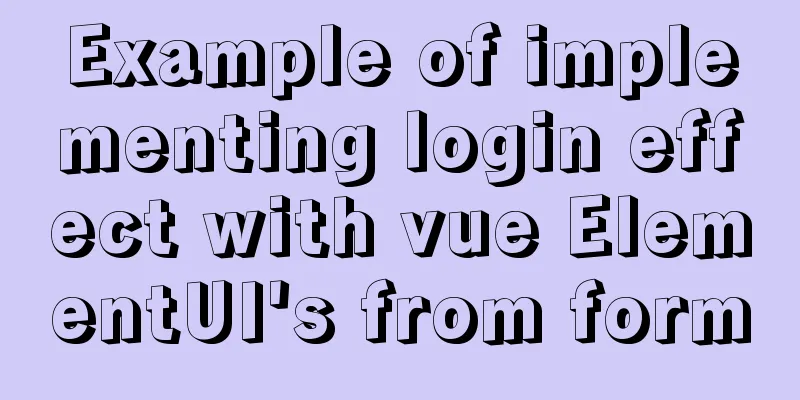OpenLayers realizes the method of aggregate display of point feature layers

1. Introduction In many cases, the number of features in a point feature layer may be hundreds or thousands. If they are directly loaded onto the map without any processing, not only will the user's visual experience deteriorate, but it will also cause the map interface to freeze. The following code creates
<!DOCTYPE html>
<html>
<head>
<meta http-equiv="Content-Type" content="text/html; charset=utf-8" />
<meta charset="utf-8" />
<title>OpenLayers</title>
<style>
html, body, #map {
width: 100%;
height: 100%;
margin: 0;
padding: 0;
}
</style>
<link href="libs/ol/ol.css" rel="stylesheet" />
<script src="libs/ol/ol.js"></script>
</head>
<body>
<div id="map"></div>
<script>
// Create 1000 random features var source = new ol.source.Vector();
for (var i = 1; i <= 200; i++) {
var coordinates = [120.00 + Math.random(), 30.00 + Math.random()];
var feature = new ol.Feature(new ol.geom.Point(coordinates));
source.addFeature(feature);
}
for (var i = 1; i <= 200; i++) {
var coordinates = [120.01 + Math.random(), 30.01 + Math.random()];
var feature = new ol.Feature(new ol.geom.Point(coordinates));
source.addFeature(feature);
}
for (var i = 1; i <= 200; i++) {
var coordinates = [120.02 + Math.random(), 30.02 + Math.random()];
var feature = new ol.Feature(new ol.geom.Point(coordinates));
source.addFeature(feature);
}
for (var i = 1; i <= 200; i++) {
var coordinates = [120.03 + Math.random(), 30.03 + Math.random()];
var feature = new ol.Feature(new ol.geom.Point(coordinates));
source.addFeature(feature);
}
for (var i = 1; i <= 200; i++) {
var coordinates = [120.04 + Math.random(), 30.04 + Math.random()];
var feature = new ol.Feature(new ol.geom.Point(coordinates));
source.addFeature(feature);
}
// Create a layer var layer = new ol.layer.Vector({
source: source,
style: function (feature, resolution) {
var style = new ol.style.Style({
image: new ol.style.Icon({
src: 'img/location.png'
})
})
return style;
}
});
// Create a map var map = new ol.Map({
target: 'map',
layers:
new ol.layer.Tile({
source: new ol.source.OSM()
}),
layer
],
view: new ol.View({
projection: 'EPSG:4326',
center: [120, 30],
zoom: 10,
minZoom: 5,
maxZoom: 14
})
});
</script>
</body>
</html>
The running results are shown in the figure below:
Doesn’t it feel disgusting to see so many points crowded together? Generally speaking, if there are a large number of points in a point feature layer, we will process it by 2. Aggregation of point feature layers In
The layer aggregation code is as follows:
<!DOCTYPE html>
<html>
<head>
<meta http-equiv="Content-Type" content="text/html; charset=utf-8" />
<meta charset="utf-8" />
<title>OpenLayers</title>
<style>
html, body, #map {
width: 100%;
height: 100%;
margin: 0;
padding: 0;
}
</style>
<link href="libs/ol/ol.css" rel="stylesheet" />
<script src="libs/ol/ol.js"></script>
</head>
<body>
<div id="map"></div>
<script>
// Create 1000 random features var source = new ol.source.Vector();
for (var i = 1; i <= 200; i++) {
var coordinates = [120.00 + Math.random(), 30.00 + Math.random()];
var feature = new ol.Feature(new ol.geom.Point(coordinates));
source.addFeature(feature);
}
for (var i = 1; i <= 200; i++) {
var coordinates = [120.01 + Math.random(), 30.01 + Math.random()];
var feature = new ol.Feature(new ol.geom.Point(coordinates));
source.addFeature(feature);
}
for (var i = 1; i <= 200; i++) {
var coordinates = [120.02 + Math.random(), 30.02 + Math.random()];
var feature = new ol.Feature(new ol.geom.Point(coordinates));
source.addFeature(feature);
}
for (var i = 1; i <= 200; i++) {
var coordinates = [120.03 + Math.random(), 30.03 + Math.random()];
var feature = new ol.Feature(new ol.geom.Point(coordinates));
source.addFeature(feature);
}
for (var i = 1; i <= 200; i++) {
var coordinates = [120.04 + Math.random(), 30.04 + Math.random()];
var feature = new ol.Feature(new ol.geom.Point(coordinates));
source.addFeature(feature);
}
// Aggregation var cluster = new ol.source.Cluster({
source: source,
distance: 100
})
// Create a layer var layer = new ol.layer.Vector({
source: cluster,
style: function (feature, resolution) {
var size = feature.get('features').length;
var style = new ol.style.Style({
image: new ol.style.Circle({
radius: 30,
stroke: new ol.style.Stroke({
color: 'white'
}),
fill: new ol.style.Fill({
color: 'blue'
})
}),
text: new ol.style.Text({
text: size.toString(),
fill: new ol.style.Fill({
color: 'white'
})
})
})
return style;
}
});
// Create a map var map = new ol.Map({
target: 'map',
layers:
new ol.layer.Tile({
source: new ol.source.OSM()
}),
layer
],
view: new ol.View({
projection: 'EPSG:4326',
center: [120, 30],
zoom: 10,
minZoom: 5,
maxZoom: 14
})
});
</script>
</body>
</html>
The running results are shown in the figure below:
3. Special treatment of polymerization Although the above code realizes the aggregation of point feature layers, there is actually a problem:
Generally speaking,
<!DOCTYPE html>
<html>
<head>
<meta http-equiv="Content-Type" content="text/html; charset=utf-8" />
<meta charset="utf-8" />
<title>OpenLayers</title>
<style>
html, body, #map {
width: 100%;
height: 100%;
margin: 0;
padding: 0;
}
</style>
<link href="libs/ol/ol.css" rel="stylesheet" />
<script src="libs/ol/ol.js"></script>
</head>
<body>
<div id="map"></div>
<script>
// Create 1000 random features var source = new ol.source.Vector();
for (var i = 1; i <= 200; i++) {
var coordinates = [120.00 + Math.random(), 30.00 + Math.random()];
var feature = new ol.Feature(new ol.geom.Point(coordinates));
source.addFeature(feature);
}
for (var i = 1; i <= 200; i++) {
var coordinates = [120.01 + Math.random(), 30.01 + Math.random()];
var feature = new ol.Feature(new ol.geom.Point(coordinates));
source.addFeature(feature);
}
for (var i = 1; i <= 200; i++) {
var coordinates = [120.02 + Math.random(), 30.02 + Math.random()];
var feature = new ol.Feature(new ol.geom.Point(coordinates));
source.addFeature(feature);
}
for (var i = 1; i <= 200; i++) {
var coordinates = [120.03 + Math.random(), 30.03 + Math.random()];
var feature = new ol.Feature(new ol.geom.Point(coordinates));
source.addFeature(feature);
}
for (var i = 1; i <= 200; i++) {
var coordinates = [120.04 + Math.random(), 30.04 + Math.random()];
var feature = new ol.Feature(new ol.geom.Point(coordinates));
source.addFeature(feature);
}
// Aggregation var cluster = new ol.source.Cluster({
source: source,
distance: 100
})
// Create a layer var layer = new ol.layer.Vector({
source: cluster,
style: function (feature, resolution) {
var size = feature.get('features').length;
if (size == 1) {
return new ol.style.Style({
image: new ol.style.Icon({
src: 'img/location.png'
})
})
}
else {
return new ol.style.Style({
image: new ol.style.Circle({
radius: 30,
stroke: new ol.style.Stroke({
color: 'white'
}),
fill: new ol.style.Fill({
color: 'blue'
})
}),
text: new ol.style.Text({
text: size.toString(),
fill: new ol.style.Fill({
color: 'white'
})
})
})
}
}
});
// Create a map var map = new ol.Map({
target: 'map',
layers:
new ol.layer.Tile({
source: new ol.source.OSM()
}),
layer
],
view: new ol.View({
projection: 'EPSG:4326',
center: [120, 30],
zoom: 10,
minZoom: 5,
maxZoom: 14
})
});
</script>
</body>
</html> The running results are shown in the figure below:
In fact, this effect is very simple to implement. The core code is: 4. Special treatment of polymerization 2 In the above code, I set the maximum zoom level of the map to
<!DOCTYPE html>
<html>
<head>
<meta http-equiv="Content-Type" content="text/html; charset=utf-8" />
<meta charset="utf-8" />
<title>OpenLayers</title>
<style>
html, body, #map {
width: 100%;
height: 100%;
margin: 0;
padding: 0;
}
</style>
<link href="libs/ol/ol.css" rel="stylesheet" />
<script src="libs/ol/ol.js"></script>
</head>
<body>
<div id="map"></div>
<script>
// Create 1000 random features var source = new ol.source.Vector();
for (var i = 1; i <= 200; i++) {
var coordinates = [120.00 + Math.random(), 30.00 + Math.random()];
var feature = new ol.Feature(new ol.geom.Point(coordinates));
source.addFeature(feature);
}
for (var i = 1; i <= 200; i++) {
var coordinates = [120.01 + Math.random(), 30.01 + Math.random()];
var feature = new ol.Feature(new ol.geom.Point(coordinates));
source.addFeature(feature);
}
for (var i = 1; i <= 200; i++) {
var coordinates = [120.02 + Math.random(), 30.02 + Math.random()];
var feature = new ol.Feature(new ol.geom.Point(coordinates));
source.addFeature(feature);
}
for (var i = 1; i <= 200; i++) {
var coordinates = [120.03 + Math.random(), 30.03 + Math.random()];
var feature = new ol.Feature(new ol.geom.Point(coordinates));
source.addFeature(feature);
}
for (var i = 1; i <= 200; i++) {
var coordinates = [120.04 + Math.random(), 30.04 + Math.random()];
var feature = new ol.Feature(new ol.geom.Point(coordinates));
source.addFeature(feature);
}
// Aggregation var cluster = new ol.source.Cluster({
source: source,
distance: 100
})
// Create a layer var layer = new ol.layer.Vector({
source: cluster,
style: function (feature, resolution) {
var size = feature.get('features').length;
if (size == 1) {
return new ol.style.Style({
image: new ol.style.Icon({
src: 'img/location.png'
})
})
}
else {
return new ol.style.Style({
image: new ol.style.Circle({
radius: 30,
stroke: new ol.style.Stroke({
color: 'white'
}),
fill: new ol.style.Fill({
color: 'blue'
})
}),
text: new ol.style.Text({
text: size.toString(),
fill: new ol.style.Fill({
color: 'white'
})
})
})
}
}
});
// Create a map var map = new ol.Map({
target: 'map',
layers:
new ol.layer.Tile({
source: new ol.source.OSM()
}),
layer
],
view: new ol.View({
projection: 'EPSG:4326',
center: [120, 30],
zoom: 10,
minZoom: 5,
maxZoom: 14
})
});
// Listen for map resolution change events map.getView().on('change:resolution', function (event) {
if (map.getView().getZoom() == map.getView().getMaxZoom()) {
cluster.setDistance(0);
}
else {
cluster.setDistance(100);
}
})
</script>
</body>
</html> The running results are shown in the figure below:
The implementation of this effect is also very simple. You only need to listen to the resolution change event of the current map. If the current zoom level is already the maximum level, set the aggregation distance to 5. Conclusion When there are a large number of elements, we should consider aggregating them, which not only improves the user experience but also avoids interface freezes. In fact, in the above code, I listened to
map.on('moveend', function (event) {
if (map.getView().getZoom() == map.getView().getMaxZoom()) {
cluster.setDistance(0);
}
else {
cluster.setDistance(100);
}
});
The same effect can be achieved by listening to the This is the end of this article about how to implement aggregate display of point feature layers in OpenLayers. For more content about aggregate display of point feature layers in OpenLayers, please search previous articles on 123WORDPRESS.COM or continue to browse the following related articles. I hope you will support 123WORDPRESS.COM in the future! You may also be interested in:
|
<<: Solution to Ubuntu 20.04 Firefox cannot play videos (missing flash plug-in)
>>: Super detailed MySQL usage specification sharing
Recommend
JavaScript to achieve simple drag effect
This article shares the specific code of JavaScri...
Detailed discussion of several methods for deduplicating JavaScript arrays
Table of contents 1. Set Deduplication 2. Double ...
Example of implementing skeleton screen with Vue
Table of contents Skeleton screen use Vue archite...
Solve the problem of MySql8.0 checking transaction isolation level error
Table of contents MySql8.0 View transaction isola...
Nginx configuration cross-domain request Access-Control-Allow-Origin * detailed explanation
Preface When a 403 cross-origin error occurs No &...
Detailed explanation of scp and sftp commands under Linux
Table of contents Preface 1. scp usage 2. Use sft...
js realizes horizontal and vertical sliders
Recently, when I was doing a practice project, I ...
Web realizes the code of popping up the window of uploading files by clicking the picture
Copy code The code is as follows: <style> ....
Common methods of Vue componentization: component value transfer and communication
Related knowledge points Passing values from pa...
What is BFC? How to clear floats using CSS pseudo elements
BFC Concept: The block formatting context is an i...
The easiest way to reset mysql root password
My mysql version is MYSQL V5.7.9, please use the ...
NodeJS realizes image text segmentation
This article shares the specific code of NodeJS t...
Centos7.5 installs mysql5.7.24 binary package deployment
1. Environmental preparation: Operating system: C...
Vue implements chat interface
This article example shares the specific code of ...
Detailed description of the use of advanced configuration of Firewalld in Linux
IP masquerading and port forwarding Firewalld sup...














